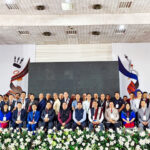Tiatemsu Longkumer, Ph.D. Student
Working on ‘Anthropology of Religion’, Dept. of Anthropology, North-Eastern Hill University, Shillong
Email: tiatemsu.l.k.r8@gmail.com
While working on Ao Naga pre-Christian religion during my literature review and fieldwork, I noticed a trend in the scholarship that no one has pointed out. Even during and after the publication of the second edition of “Ancient Ao Naga Religion and Culture” by Panger Imchen, no one seems to have pointed it out. Taking Imchen’s second edition of the book as my basis, I will give a concise and humble critical observation suggesting that works by Ao theologians on Ao traditional religion are a process of what I call “Christianization of Ao traditional religion” (this article is a section of my thesis which I’m currently working on).I will be using the word “traditional religion” to signify “ancient Ao Naga religion” or “pre-Christian religion.”
If Panger Imchen were still alive today, I believe he would have revised the book drastically because there has been tremendous development and works on the subject matter. The introduction to the second edition (p.2-3) suggests that other authors have the tendency to romanticize traditional ‘cosmology,’ but my observation is that other Ao Naga authors have Christianized Ao traditional religion. By Christianized, I mean understanding Ao traditional religion through Christian concepts rather than understanding it through the lens of Ao Nagas. Interestingly, Imchen also writes with the same motivation in his mind (p.5). Another motivation of the book where Imchen suggests that “Ao religious beliefs…worked as a foundation for coming of the gospel of Christ” (p.6) makes this book about Christianizing Ao traditional religion rather than understanding it.
The author argues against using the word ‘animism’ to signify Ao traditional religion (p. 13-15). While arguing his position, he takes E. B. Taylor’s work out of context (To know how Imchen makes the same mistake as other authors in understanding animism, see Martin D. Stringer’s “Rethinking Animism”). Animism does not signify any categories of religion, nor is the religion of unsophisticated people (To understand what animism is, see works by Sarah Pike, Graham Harvey, and David Haberman). Animism does not mean primitive like Imchen mistakenly observed due to his misinterpretation of Taylor’s thought. Ao Naga’s traditional religion is “animism.” Imchen is constrained by the colonial imputation of Christian conceptual thinking in trying to understand animism.
Imchen equates the concept of tsüngremwith God and suggests that tsüngrem “is a common name given at different times according to his revelation and manifestations” (p.17). Equating tsüngremwith God results from Imchen’s training in theology where the issue of ‘ultimate,’ ‘absolute,’ and ‘prime/first mover,’ (p. 10-11) are debated and discussed while trying to understand deities/God. Consequently, when Imchen got a hinge of a ‘conscious being’ (p. 49) among Ao’s, he quickly equated it to God. The Ao Nagas never debated or discussed such concepts, nor did they have such concepts because their deities were temporal. Consequently, and very predictably, Imchen equates the Ao concept of tsüngremto the Vedic idea of God, where God is equated with ‘reality’ (p. 49). But the concept of tsüngremcan’t be equated with Brahman because, unlike Brahman, tsüngrem does not manifest any form of reality. Imchen’s usage of the words like ‘revelation’ and ‘manifestation’ is also clearly Christian philosophical motivated words/concepts. The Christian concept of ‘revelation’ does not apply to Ao’s traditional religion because there is no ontological barrier between humans and other deities in Ao traditional religion. There are only different ontological categories rather than a barrier. Invariably, Imchen’s argument that various deities among Ao Nagas are manifestations of tsüngrem(God) is mistaken. Such view comes from a Christian concept of God in the Old Testament, which gives God different names according to its attributes (read J. A. Loewen, “The Names of God in the Old Testament”). Due to such Christian influence, Imchen creates confusion when he argues that, “The various Tsüngrem are given to one eternal God, Jungphodemdem, the All-powerful, Almighty, the Highest above who is ONE….” (p. 67). At one instance, he argued that tsüngremis God, and now he is arguing that jungphodemdemis the one eternal God. I’ve argued that Jungphodemdemcan be understood as the essence of living being (human and non-human) rather than one eternal God.In light of such findings, Imchen’s category of ‘minor deities’ is also mistaken because there are no minor or major deities among Ao’s.
Writing on Lichaba, Imchen suggests that Lichabais the creator of the earth and everything else. This understanding of Lichaba as a creator is a later Christianized understanding of Lichaba. The more apt English word that can signify Lichabais ‘designer’ rather than creator. The concept of creation entails a metaphysically distinct reality devoid of human temporal time and substance. This metaphysically different reality, which some call ‘prime mover’ or God, initiates the process of cause and effect. The Ao stories, songs,dances, rituals, and other cultural practices do not indicate such a metaphysically different reality.
Imchen suggests that “…Ao religion is devoid of…salvation…” (p. 15). Such remark is another way of understanding Ao’s traditional religion from a Christian standpoint. Salvation is only needed when there is a particular understanding of ‘sin’ (read Jeffrey Siker’s book “Sin in New Testament”). Sin (abstract and practical) should be attached to a metaphysically infinite being (God) for salvation to make sense. The Ao’s have a concept of menenbut are not attached to a metaphysically infinite being. Thus, the concept of salvation only works in religions like Christianity. To argue that Aos does not have the concept of salvation is to look atAo’s traditional religion from a biased Christian lens.
Many more critical remarks can be made about the book, but as I’ve argued, the book is trying to Christianize Ao’s traditional religion and not understand Ao’s traditional religion. Ao theologians (O. Alem, C. Walu Walling, Tajen Ao, A. Wati Longchar, Takatemjen, and so on) have written on Ao traditional religion and have successfully Christianized it. Interestingly even the scholars who are not from theology background refer to the works by Ao theologians and propagate the Christianized understanding of Ao traditional religion. My work tries to understand Ao traditional religion devoid of Christian concepts. Thus, the understanding of Ao traditional religion is in a very nascent stage, and more scholars need to start rethinking Ao traditional religion.



